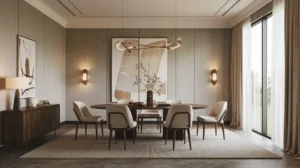This post may contain affiliate links. As an Amazon Associate, we earn a small commission at no extra cost to you.
There’s something magical about a farmhouse dining room that just feels like coming home. Maybe it’s the way the style balances rustic charm with practical comfort, or how it somehow manages to be both timeless and on-trend. Whatever the reason, I’ve fallen hard for farmhouse dining spaces—and I’m not alone.
When my partner and I bought our first home (a 1940s fixer-upper with good bones but questionable design choices), the dining room became my pet project. After countless hours scrolling inspiration, testing paint samples, and hunting for the perfect pieces, I’ve learned that creating a farmhouse dining room isn’t about buying a matching furniture set from a catalog. It’s about thoughtfully layering elements that tell a story while creating a space where people actually want to linger over meals.
Whether you’re starting from scratch or looking to refresh your existing dining space, these 20 Farmhouse Dining Room Decor Ideas blend that coveted country charm with practical solutions for today’s homes. Let’s transform your dining room into the heart of your home—a place where memories are made around good food and better conversation.
1. The Statement Farmhouse Table

A proper farmhouse dining room starts with the table—it’s the heart of the space and sets the tone for everything else. Look for substantial pieces with character: thick wooden tops, turned legs, or trestle bases all channel authentic farmhouse style.
The beauty of a farmhouse table is in its imperfections. Weathered finishes, visible grain, and even a few knots or marks tell a story and promise to age gracefully as you add your own history to the piece. I splurged on a reclaimed wood table two years ago, and it’s become the gathering spot for not just meals but game nights, craft projects, and late-night conversations. Worth every penny.
Recommended selections available on Amazon:
2. Mix-and-Match Seating with Purpose
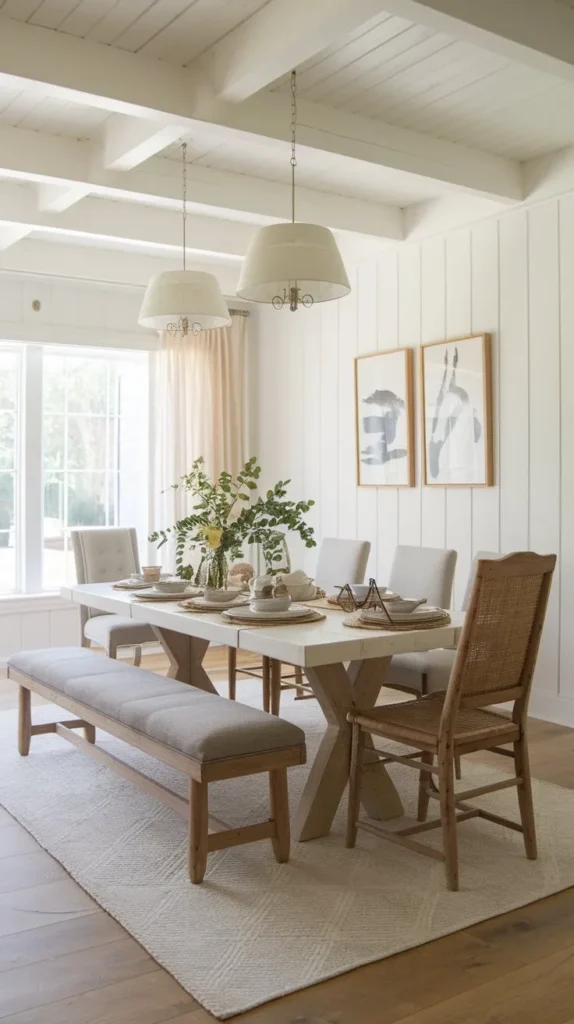
Matching dining sets can feel a bit showroom-sterile. The farmhouse style embraces more collected, intentional combinations—think wooden side chairs paired with a cushioned host chair or even a bench along one side.
This approach isn’t just stylish; it’s practical too. A bench can accommodate extra guests when needed or be tucked completely under the table when you want more floor space. When choosing mixed seating, keep some element consistent—similar wood tones, complementary fabrics, or cohesive silhouettes—to ensure everything still feels intentional. In my own space, I paired simple wooden chairs with a cushioned bench, and the flexibility has been perfect for everything from intimate dinners to holiday gatherings.
Recommended selections available on Amazon:
- ♬【Vintage Dining Table Set】This retro-style dining set comes with a spacious table, four beautifully crafted chairs and …
- ♬【Notable Details】The trestle bases of the table and bench are designed with a three-dimensional groove carving pattern,…
- ♬【Superior Quality】Constructed from high-quality materials, this dining set promises stability and durability. The table…
3. Statement Pendant Lighting That Anchors the Space
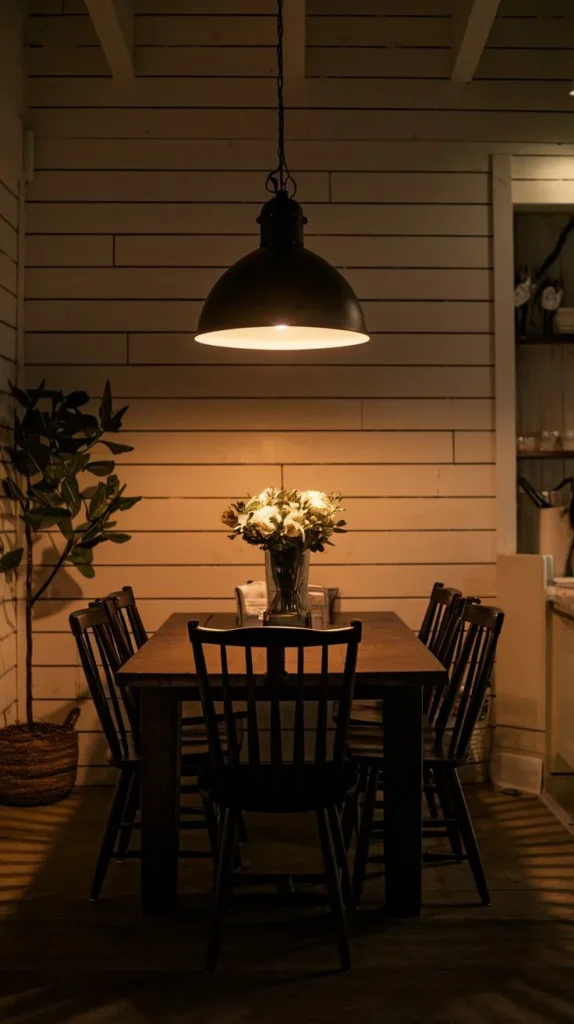
Farmhouse dining rooms thrive with lighting that makes a quiet statement—substantial but not flashy. Oversized pendants in black metal, aged brass, or even woven natural materials create a focal point while casting the perfect glow for shared meals.
Hanging height matters enormously here. Mount your pendant 30-36 inches above the table surface for the most flattering light without blocking sightlines across the table. I learned this the hard way after initially hanging our metal pendant too high—once we lowered it, the entire room suddenly felt more intimate and intentionally designed.
Recommended selections available on Amazon:
- Size (Shade): 9.8″Hx13.7″Wx13.7″W
- MATERIAL: The lamp is made of metal. It is perfect for kitchen island, dining room, living room, Bedroom, office
- Height Adjustable: The length of the cord and the direction of the light arm can be adjusted. The max adjustable length …
4. Open Shelving with Curated Collections

Farmhouse style celebrates everyday items beautifully displayed rather than hidden away. Open shelving—whether built-in or freestanding—provides the perfect opportunity to showcase collected dishware, serving pieces, and meaningful objects.
The key is thoughtful curation rather than cluttered storage. Group similar items (stacked plates, clustered glassware), incorporate a few plants or natural elements, and leave some breathing room between vignettes. We installed simple wooden shelves along one dining room wall, displaying my grandmother’s ironstone collection mixed with everyday dishes—practical storage that doubles as a personal design statement.
Recommended selections available on Amazon:
5. The Textural Neutral Rug

A proper farmhouse dining room needs grounding, and a textural neutral rug delivers functionality with style. Look for natural fibers like jute, sisal, or a cotton-wool blend that can handle inevitable dining mishaps while adding essential warmth.
Size matters enormously here—your rug should extend at least 24 inches beyond the table edge on all sides, allowing chairs to remain fully on the rug even when pulled out. After living with a too-small rug that constantly caught on chair legs, I finally invested in a properly sized jute rug with a subtle pattern. The difference was immediate—both in how the space looked and how it functioned for daily use.
Recommended selections available on Amazon:
- Versatile 60×96 Inches Chunky Jute Area Rug: The perfect size for living rooms, bedrooms, and offices, this jute rug enh…
- Handwoven Eco-Friendly Jute Rug: Crafted by skilled artisans from 100% natural jute, this sustainable rug is biodegradab…
- Textured & Stylish Natural Fiber Rug: The thick, chunky weave adds warmth and character to any space, offering a rustic …
6. Shiplap or Beadboard Wall Treatments

Nothing says farmhouse quite like textured wall treatments that add architectural interest. Shiplap (horizontal boards), beadboard (vertical grooved panels), or board-and-batten details instantly infuse authentic farmhouse character even in newer homes.
You don’t need to cover every wall—a single accent wall behind a buffet or applied to the lower third of the room as wainscoting can deliver major impact without overwhelming the space. We added horizontal shiplap to our dining room’s main wall, painted in soft white, and it immediately gave our basic 1940s space the charming architectural detail it was lacking.
Recommended selections available on Amazon:
- Dimensions: 94-1/2 in. Width x 24-1/4 in. Height x 0-3/8 in. Thickness x 15.91 Sq. Ft.
- Kit includes 5 of 19″W x 12 1/8″H panel pieces only
- Baseboard and chair rail are not included
7. The Multipurpose Sideboard or Buffet

Farmhouse dining rooms balance beauty with practicality, and nowhere is this more evident than in a hardworking sideboard. Look for pieces with a combination of concealed storage (for items you need but don’t want to display) and open shelving or glass-front sections for prettier pieces.
Vintage or antique pieces often offer unique character at reasonable prices, but new pieces designed with farmhouse aesthetics work beautifully too. Look for substantial hardware, quality construction, and finishes that complement your table without matching exactly. My once-neglected dining room corner now features a refinished vintage sideboard that stores everything from table linens to serving pieces while displaying family photos and favorite objects.
Recommended selections available on Amazon:
- Mid-Century Modern Design:This 55-inch fluted buffet cabinet is a stylish and practical choice for modern living spaces….
- Elegant Curved Edge Design:The sideboard’s curved edges create a sleek and refined look, with two side compartments feat…
- Spacious Storage Capacity:This buffet cabinet offers ample storage with two large side compartments and three smooth-gli…
8. Textured Window Treatments That Frame the View
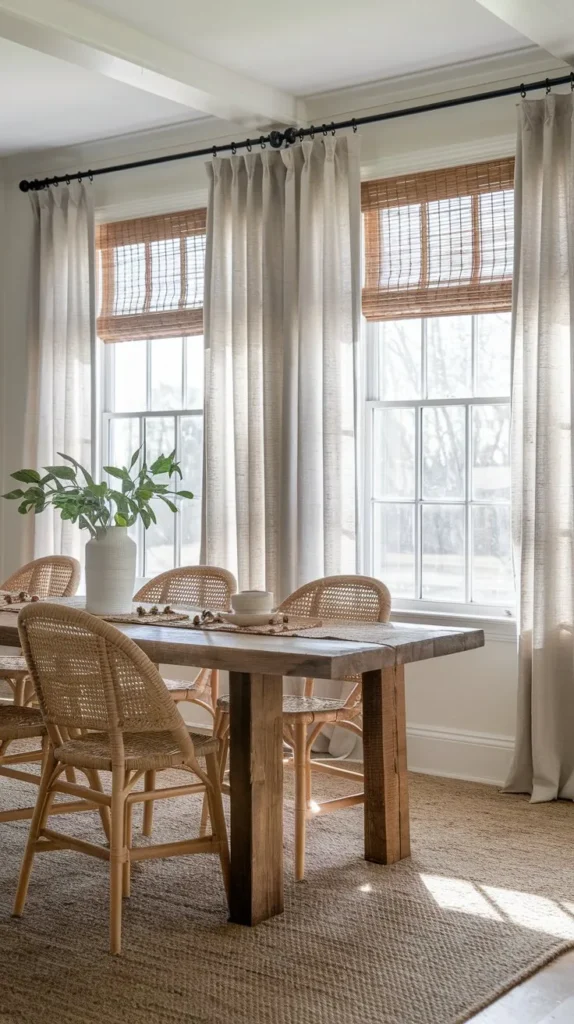
Farmhouse dining spaces need window treatments that add softness while maintaining a connection to the outdoors. Look for natural materials and textures—woven wood shades, simple linen curtains, or even drop cloth panels—that filter light beautifully.
Hang curtains high and wide to maximize natural light and make windows appear larger. The panels should just kiss the floor or puddle slightly for that casual elegance that defines farmhouse style. After years of standard blinds, I finally hung simple unbleached cotton curtains mounted near the ceiling—the room instantly felt taller, brighter, and more finished.
Recommended selections available on Amazon:
9. The Vintage-Inspired Area Rug
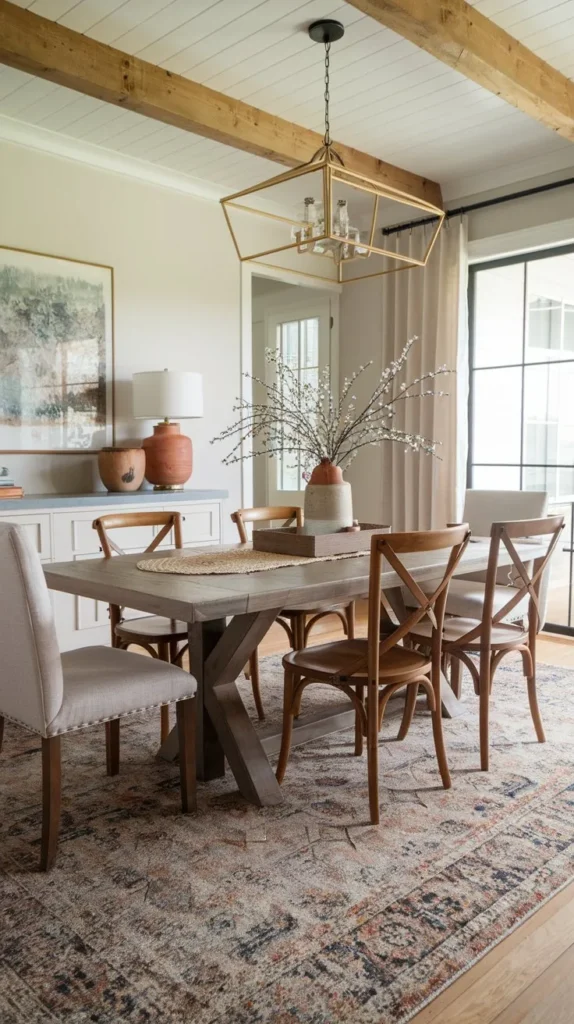
While natural fiber rugs are farmhouse staples, vintage-inspired patterned rugs offer another authentic option with more color and visual interest. Look for faded patterns in muted colors that feel gently aged rather than bright and new.
These rugs bring instant character and help define the dining area, especially in open-concept spaces. The subtle pattern also forgives the inevitable dining room spills and crumbs better than solid options. After trying various rug styles, I landed on a muted blue vintage-inspired pattern that anchors our dining space while complementing the warmer woods and whites throughout the room.
Recommended selections available on Amazon:
- Durable Materials: Our area rug is meticulously crafted from 100% Polypropylene and made in Turkey, ensuring exceptional…
- Recommended Rooms: Transform your living room, bedroom, kitchen, nursery, office, or dining room with this stunning 7×9 …
- Stylish & Versatile Design: This Medallion rug boasts enduring, captivating aesthetics. Its Medallion pattern and unique…
10. Wall Art That Tells a Story

Farmhouse dining rooms shine with wall art that feels collected rather than perfectly coordinated. Look for pieces with meaning—vintage botanical prints, antique farm scenes, or even framed family recipes—that spark conversation around the table.
Scale matters enormously here. Err on the side of larger pieces or thoughtfully arranged collections rather than scattered small frames that create visual clutter. My dining room features a large vintage map of our county from the 1920s, flanked by smaller framed botanical prints—meaningful to our location but also visually striking.
Recommended selections available on Amazon:
- 【Green Leaves Wall Art】The decorative paintings showcase a minimalist design, primarily featuring beige and sage green t…
- 【Perfect Home Decor】The captivating set of nature-theme wall art is the perfect choice for enhancing the decor of your l…
- 【Effortless to Display】The framed mountains wall art set includes three pieces, each measuring 24×36 inches×3pcs (60×90c…
11. Statement Chandelier with Rustic Elements

Lighting creates ambiance, and a statement chandelier becomes the jewelry of your farmhouse dining room. Look for fixtures that incorporate rustic elements—distressed wood, black or aged metal, clear glass—while providing proper illumination for your dining activities.
Consider scale carefully—your chandelier should be about 1/2 to 2/3 the width of your table to look proportional. Too small, and it disappears; too large, and it overwhelms. We replaced our dining room’s dated fixture with a black metal and wood chandelier that balances rustic and modern perfectly—every dinner guest comments on how it transforms the space.
Recommended selections available on Amazon:
- Elegant Wood-Grain Finish — This wagon wheel chandelier features an elegant wood-grain finish. Crafted from iron, the w…
- Adjustable Hanging Height — Wood grain farmhouse light fixture is designed with three black metal hanging chains (11.81…
- Wide Range of Applications — Combining classic and modern elements, this farmhouse wagon wheel chandelier is ideal for …
12. Natural Elements That Bring the Outdoors In

Farmhouse style is intrinsically connected to nature, and incorporating natural elements keeps dining spaces feeling fresh and authentic. Consider a centerpiece of seasonal branches, a collection of houseplants along a window ledge, or even preserved botanicals in simple vessels.
These touches needn’t be elaborate or expensive—clippings from your yard, market flowers arranged simply, or even a bowl of natural objects collected on walks add that authentic touch that can’t be replicated with artificial alternatives. My dining table features a dough bowl filled with changing natural elements—pinecones in winter, fresh herbs in summer—that keeps the space feeling connected to the seasons.
Recommended selections available on Amazon:
- Dimensions: The planter box is 17 inches long, 5 inches wide, and 4 inches high with an interior dimension of 16 inches …
- Quality: Handmade from durable Paulownia wood with a removable watertight plastic liner to prevent leakage.
- Design: The sturdy wood walls are glued and nailed together for strength and durability. The clear plastic liner keeps s…
13. Woven Natural Fiber Baskets for Style and Storage

Storage that looks good is the holy grail of home design, and natural fiber baskets deliver this beautifully in farmhouse dining spaces. Use them tucked beneath a sideboard for linens, arranged on open shelving for visual texture, or even as oversized vessels for houseplants.
The natural variations in handwoven baskets add authentic character while performing essential storage duties. After struggling with dining room clutter, I incorporated a collection of baskets in various sizes—they now corral everything from cloth napkins to kids’ art supplies, keeping essentials accessible but visually contained.
Recommended selections available on Amazon:
14. Classic White Dishware for Timeless Appeal
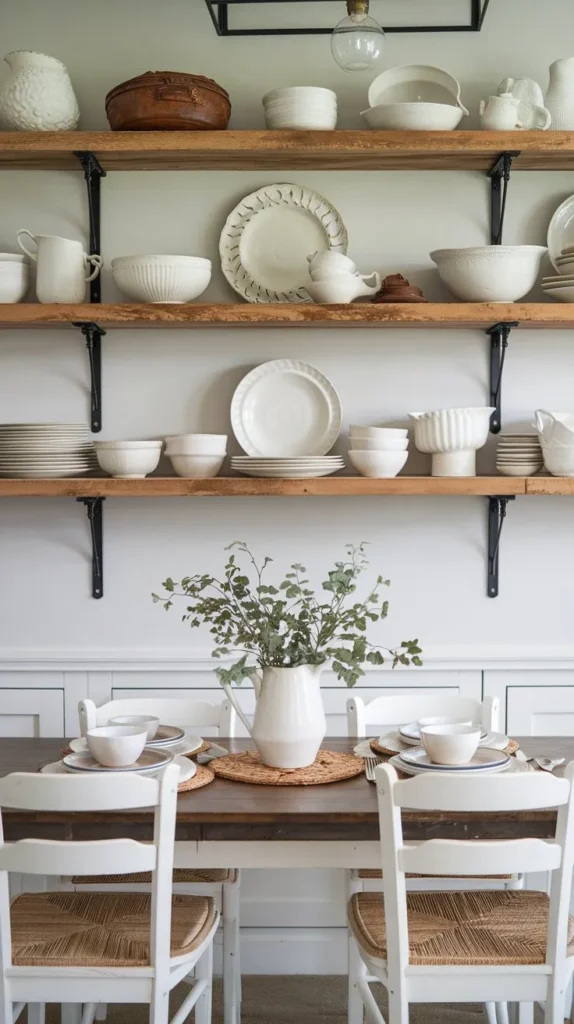
Farmhouse dining rooms celebrate the beauty in everyday objects, and nothing embodies this better than classic white dishware. Whether displayed on open shelving, arranged in a hutch, or set on your table, white ceramics offer timeless appeal that works with any color scheme.
Mix profiles and textures rather than perfectly matched sets—some pieces with beaded edges, others with subtle patterns, and perhaps some vintage ironstone mixed with newer pieces. My collection started with my grandmother’s ironstone plates and has grown to include everything from modern matte serving bowls to vintage milk glass—all unified by their creamy white palette.
Recommended selections available on Amazon:
- WHAT’S IN THE BOX: Service for 8 that includes 8 of each of the following: 10.5” Dinner Plates, 8.5” Dessert Plates, 6” …
- CARE INSTRUCTIONS: a beautiful set that is also microwave and dishwasher safe.
- EMBOSSED AB-GRADE PORCELAIN: a durable, lightweight, BPA-free, and heat-resistant material made from 100% natural minera…
15. Layered Table Linens for Depth and Texture
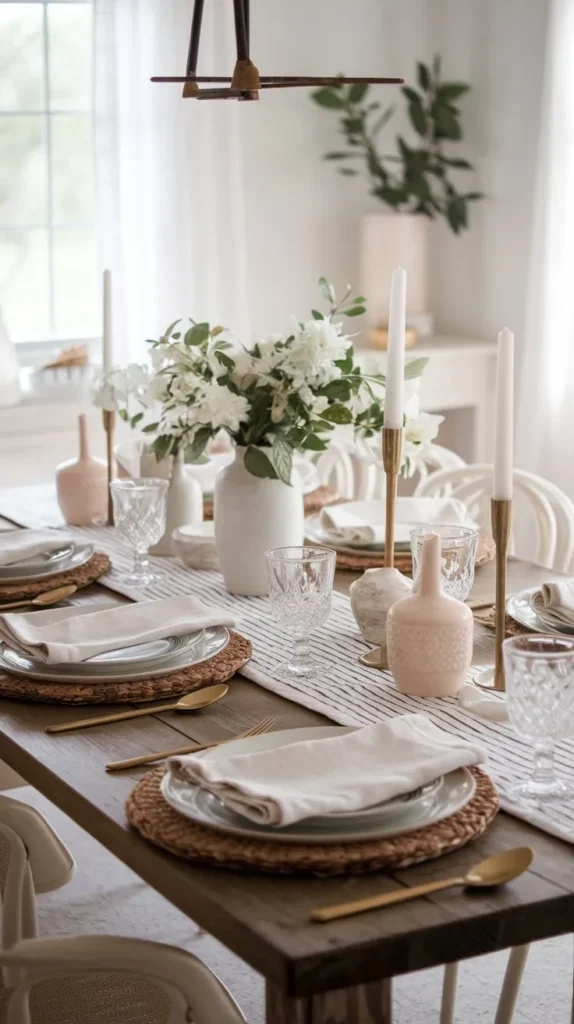
Farmhouse tables shine when adorned with thoughtfully layered linens that add color, pattern, and texture. Rather than formal matched sets, consider combinations—a textured runner down the center, cloth napkins in complementary colors, and perhaps placemats for daily use.
Natural fabrics are key here—linen, cotton, and canvas all age beautifully and embody the practical luxury of farmhouse style. After collecting various table linens over years, I’ve found that a simple striped runner paired with solid napkins creates the perfect backdrop for everyday meals while remaining easy to swap out seasonally.
Recommended selections available on Amazon:
- Material: Premium cotton fabric with natural wrinkle, soft and absorbent, easy to shape, the edges don’t fray easily.
- Boho Themed Table Decor: Rustic colors, simple and practical, suitable for pairing with napkin rings, working out nicely…
- Package: Each pack contains 6 pieces, each piece measures 16 x 16 Inches.
16. Antique or Vintage Accent Pieces with History

Farmhouse dining rooms benefit enormously from incorporating a few genuine old pieces that bring instant history and character. Look for small wooden stools, antique serving pieces, vintage artwork, or even architectural salvage that can be repurposed decoratively.
These touchstones of authenticity anchor newer elements and create that collected-over-time feeling that defines true farmhouse style. My most treasured dining room element is a small antique stepback cabinet found at a local estate sale—it stores special occasion dishes while adding architectural interest that new pieces simply can’t replicate.
Recommended selections available on Amazon:
- Poplar Solids w/ Cathedral White Oak Veneer
- Antique White Finish
- Full Extension Metal Side Drawer Guides
17. Comfortable Upholstered Host Chairs for Lingering Meals
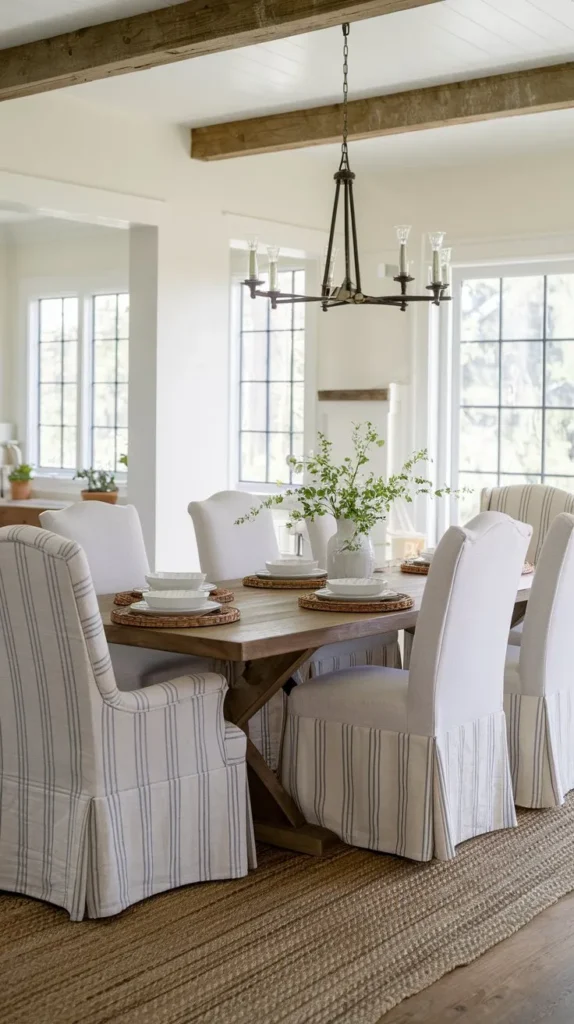
Farmhouse dining is about gathering and lingering, and comfortable seating encourages just that. Consider upholstered host chairs at the table ends—these special “captain’s chairs” with arms and cushioned seats invite people to settle in for long conversations.
Look for neutral upholstery in durable, natural fabrics like cotton duck, linen blends, or even leather that will age gracefully with use. After multiple dinner parties where conversations stretched late into the evening, I upgraded to upholstered host chairs with subtle pattern and proper armrests—they’ve transformed not just how our dining room looks, but how we use it.
Recommended selections available on Amazon:
- Ca Foam / Polyester Fiber
- The beige slipcovers of this side chair will give your home a chic accent
- This chair features a seat height of 17 inches
18. A Collected Gallery Wall of Meaningful Art

Farmhouse dining rooms shine with wall displays that feel collected over time rather than purchased as matching sets. Create a gallery of framed pieces that have personal significance—family photos, landscapes of places you’ve visited, vintage illustrations of favorite flora or fauna.
The key is finding a unifying element—similar frames, a consistent color palette, or a thematic connection—while embracing pleasant imperfection. My dining room’s gallery wall features black-framed botanical prints mixed with family photos converted to sepia tones, creating visual cohesion despite the varied content.
Recommended selections available on Amazon:
- Botanical Wall Art: These botanical wall art framed pictures provide sensuous qualities and beauty through 6 sage green …
- Green Plant Wall Art Prints: Eucalyptus pictures prints using HD GICLÉE printing tech ensures vibrant colors on premium …
- Botanical Prints Set of 6: 8x12inches x2, 10x14inches x2, 12x16inches x2(20x30cm x2,25x35cm x2, 30x40cm x2) Ready to han…
19. The Perfect Farmhouse Clock as Functional Decor

Clocks in farmhouse dining rooms serve as both practical timekeepers and substantial decorative elements. Look for oversized pieces with visible numerals and simplified styling—whether vintage schoolhouse clocks, reproduction train station styles, or simple wooden versions with painted faces.
Position your clock where it’s visible from the table but doesn’t dominate the entire space—often above a sideboard or on a wall visible from most seats. After hunting for months, I found a 24-inch wooden clock with black metal accents that has become not just a timekeeper but a defining style element in our dining space.
Recommended selections available on Amazon:
- Nullify
- SIZE MATTERS – This battery-operated clock has a 24″ height, 2″ depth and 24″ length making it the perfect wall clock fo…
- IT’S IN THE DETAILS – Our round Rustic Barn Wood Wall Clock has a stained dark brown finish and is made of solid wood wi…
20. Seasonal Centerpieces That Celebrate Natural Rhythms
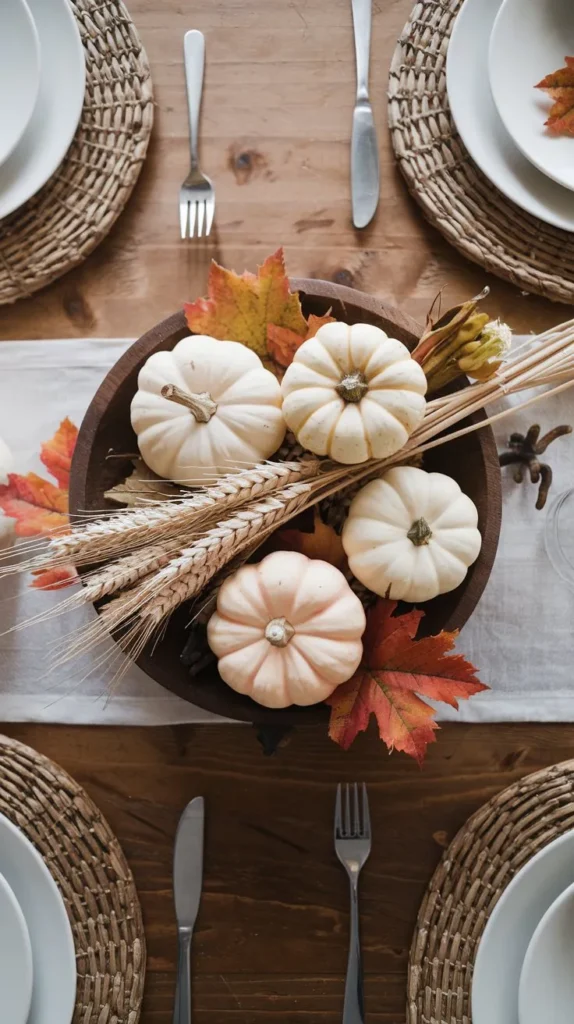
Farmhouse style is inherently connected to seasonal rhythms, and your dining table centerpiece offers the perfect opportunity to celebrate these changes. Rather than artificial arrangements, embrace simple groupings of seasonal elements—budding branches in spring, fresh herbs in summer, colorful gourds in fall, and evergreen clippings in winter.
The key is simplicity and authenticity—items that might actually have been found on a working farm arranged without fuss or pretension. I keep a large wooden dough bowl on our table year-round, changing its contents with the seasons—it’s become a visual calendar that keeps our dining space feeling fresh and connected to the world outside.
Recommended selections available on Amazon:
- SIZE – 8 (Diameter) x 2 (Height) Inches
- WHAT’S IMPORTANT – Clean with a soft, dry cloth. Do not put in dishwasher. Ideal for small bedside or countertop items s…
- HAND CRAFTED & ECO FRIENDLY – Hand made using simple artisan tools & high quality, legally harvested Mango Wood. The woo…
Creating Your Farmhouse Dining Room: A Thoughtful Approach
True farmhouse style isn’t about rushing out to buy everything at once or following a rigid formula. It’s about thoughtfully curating a space that feels authentic to both the aesthetic and your family’s actual lifestyle. The most successful farmhouse dining rooms evolve over time, incorporating pieces with meaning and function rather than simply checking style boxes.
Begin with the elements that will make the biggest impact in your specific space—perhaps that statement table, upgraded lighting, or textured wall treatment. Then layer in additional elements as budget and opportunity allow, always prioritizing quality and authenticity over quantity.
Remember that the ultimate goal of a farmhouse dining room isn’t just creating a pretty space for photographs—it’s designing a welcoming environment where memories are made around shared meals. A space where people naturally want to linger, where conversations flow easily, and where the distractions of modern life fade away in favor of genuine connection.
I’d love to hear which of these ideas sparked inspiration for your own farmhouse dining space! Drop a comment below sharing your favorite element or a cherished piece that anchors your dining room. Here’s to creating dining spaces that honor the past while making room for new traditions and memories around your table. Ready for more inspiration? Check out these 20 Elegant Dining Room Decor Ideas to kickstart your next makeover.





























